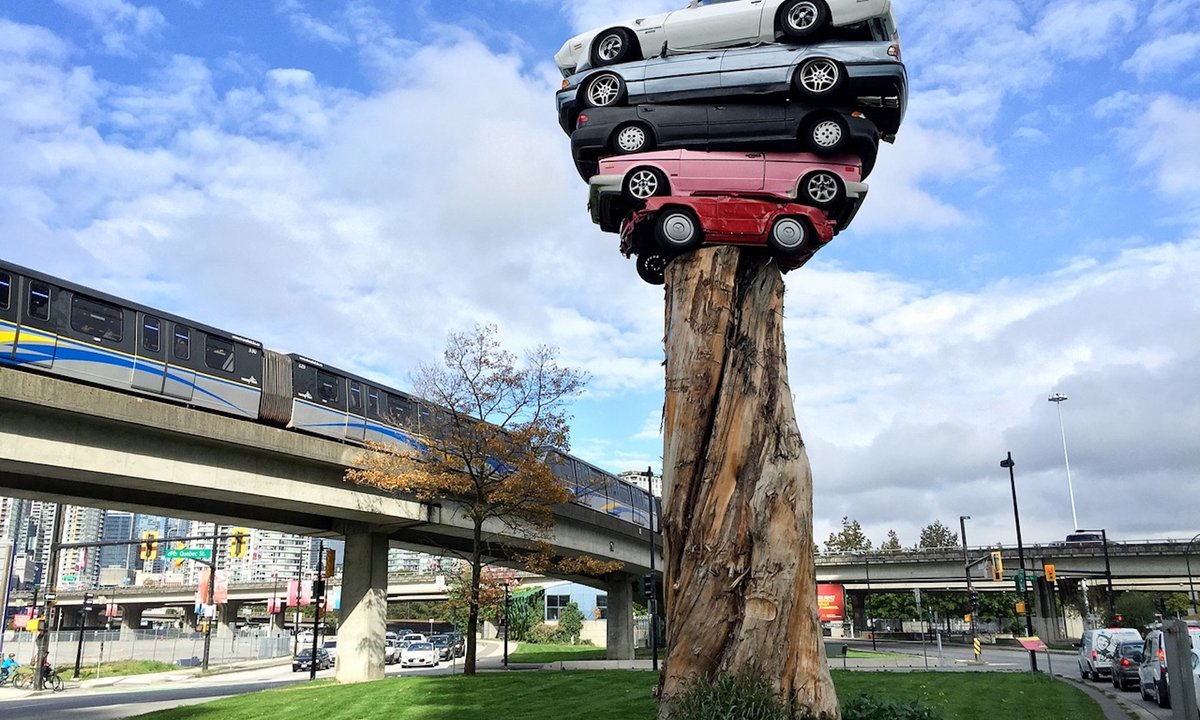A towering public sculpture in Vancouver has become a vehicle for civic antinomy, setting off a dispute pitting its creators and fans against residents who claim its proposed relocation to their neighbourhood will block their views.
Marcus Bowcott and Helene Aspinall’s Trans Am Rapture (2015)—a 33-ft-tall sculpture originally titled Trans Am Totem that consists of five salvaged cars stacked atop the trunk of an old-growth cedar tree—was initially installed temporarily as part of the 2014-16 Vancouver Biennale. In 2019, Chip Wilson, the local philanthropist and founder of the Lululemon athletic apparel company, donated C$250,000 ($201,000) to save the sculpture and make it part of the city’s permanent public art collection.
The work suffered damage after pigeons took up residence inside it and in 2021 it was dismantled and removed from its original Northeast False Creek location on Quebec Street’s median for cleaning and repair. The sculpture, part of a body of work described on the artists’ website as focussing “on human activity in relation to the natural environment”, was refurbished with bird-proofing measures, including metal mesh to prevent nesting and damage. But four years later, after the city and the artists finally agreed on a new home for the sculpture in a park next to the southwest corner of the Granville Street Bridge, and after foundations has been laid for its planned installation there this month, the city cancelled the plans on 30 July in response to a neighbourhood petition in opposition.
“City staff have been asked to revisit previously assessed locations and explore potential new ones that can better accommodate the artwork,” a municipal statement explains, adding the “the existing concrete pad at the site will be repurposed to support a future, smaller-scale public art installation”.
The petition was initiated by Doreen Forst, who owns a condo near the site and feared the installation would block her view. “This sculpture stands 10m (three storeys) high and is an inappropriate imposition on the residential Fairview neighbourhood known for its beautiful views of the North Shore,” she wrote in the petition, which garnered more than 250 signatures. “This is not the right location for this structure.”
Then, just as it seemed the NIMBY (Not In My Back Yard) contingent had prevailed, an opposing petition was launched on 2 August in favour of the new location for the sculpture. Organised by Michael Rozen, a friend of the artists, that petition gathered more than 700 signatures as of this writing.
“The few mutually agreeable sites that the Cultural Services Department had offered were later revoked by public art officials at the city,” Rozen writes in the petition. “This process of offering and revoking sites has gone on for four years.” He claims that the sculpture is “less than half the size of the many surrounding trees in the park” and will not block any views as “it is on a downward north-facing slope close to the busy traffic on 4th Avenue and beside [the] eight-lane Highway 99 Granville Bridge. The site is an excellent context for the sculpture, and many in the community want it there.”
Despite the support garnered by Rozen’s petition, Bowcott is sceptical it will succeed in reversing the outcome. “I’m not sure,” he tells The Art Newspaper. “I wouldn’t want to bet on it. City Hall is a murky entity.”
Bowcott says that the Vancouver Biennale’s president, Barrie Mowatt, is hoping Trans Am Rapture will instead be installed at the Granville Loop (a bus stop near the proposed site). The artist maintains that the sculpture’s original site was the best, “primarily because it was beside the rapid transit, cycle paths and roads and it could be seen from a great distance or up close, the site offered great contrasts in terms of scale. The Granville Loop site will be primarily an ‘up close’ experience.”
The controversy around Transam Rapture’s relocation has given the work new layers of meaning. While public art and real estate values are inexorably linked in many cities, and such controversy isn’t new here, the current brouhaha has transformed Bowcott and Aspinall’s sculpture into a crucible for issues endemic to Vancouver, a city built on resource extraction and boom and bust real estate cycles.
Bowcott says the work is intended as a “response to the curated hierarchies of the art world”, he adds that “our cultural fabric is frayed and torn. Income disparities and growing social hierarchies have engendered alienation. The fractures existing in our political, social and religious realms are echoed in the art world.”
“‘Log it, burn it and pave it’ was a quip I first heard when I worked on log booms and work boats,” Bowcott says of his art student days, when piles of old cars on barges first caught his eye. “Fifty years later, I consider what I and we have witnessed to be a cultural clear cut. I consider Trans Am Rapture to be about our environmental dilemma as well as our cultural dilemmas.”

